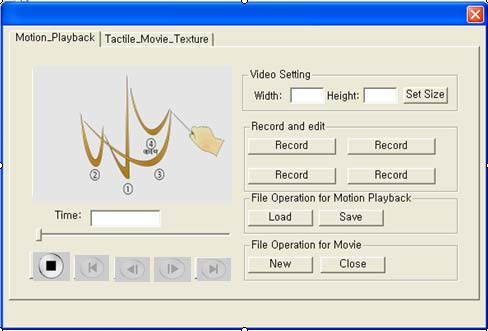Cha et al. Authoring

Tool Summary
| Metadata | |
|---|---|
| Release Yearⓘ The year a tool was first publicly released or discussed in an academic paper. | 2007 |
| Platformⓘ The OS or software framework needed to run the tool. | Windows |
| Availabilityⓘ If the tool can be obtained by the public. | Unavailable |
| Licenseⓘ Tye type of license applied to the tool. | Unknown |
| Venueⓘ The venue(s) for publications. | IEEE WHC |
| Intended Use Caseⓘ The primary purposes for which the tool was developed. | Haptic Augmentation |
| Hardware Information | |
|---|---|
| Categoryⓘ The general types of haptic output devices controlled by the tool. | Vibrotactile, Force Feedback |
| Abstractionⓘ How broad the type of hardware support is for a tool.
| Bespoke |
| Device Namesⓘ The hardware supported by the tool. This may be incomplete. | 76-Tactor Glove, Phantom |
| Device Templateⓘ Whether support can be easily extended to new types of devices. | No |
| Body Positionⓘ Parts of the body where stimuli are felt, if the tool explicitly shows this. | Hand |
| Interaction Information | |
|---|---|
| Driving Featureⓘ If haptic content is controlled over time, by other actions, or both. | Time |
| Effect Localizationⓘ How the desired location of stimuli is mapped to the device.
| Location-aware |
| Non-Haptic Mediaⓘ Support for non-haptic media in the workspace, even if just to aid in manual synchronization. | Visual |
| Iterative Playbackⓘ If haptic effects can be played back from the tool to aid in the design process. | Yes |
| Design Approachesⓘ Broadly, the methods available to create a desired effect.
| Direct, Procedural, Additive |
| UI Metaphorsⓘ Common UI metaphors that define how a user interacts with a tool.
| Keyframe, Demonstration |
| Storageⓘ How data is stored for import/export or internally to the software. | MPEG-4 BIFS |
| Connectivityⓘ How the tool can be extended to support new data, devices, and software. | None |
Additional Information
The authoring tool described by Cha et al. is meant to create interactions to be broadcast using MPEG-4 Binary Format for Scenes (BIFS). Haptic effects are represented through different “nodes” that support moving a force-feedback device along a trajectory, guiding a force-feedback device to a specific position, and triggering vibration on a tactile array. The tool itself supports recording motion on a force-feedback device for use in these nodes and an interface for creating and aligning vibration effects with pre-existing video files.
For more information, consult the WHC’07 paper.